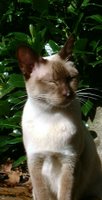Personality: Another stab

Still cognitating about personality because it is important to what I want to write. Today, stroking the one cat I have left, a jumpy, affection-seeking Tonkinese, I listed to her, like a Buddhist mantra, the names of all the past felixes I have known: she knew the last one. The fact that they were so distinct, had clearly remarkable personalities, made me think of the business of the blackbirds: research has shown they were not black to other blackbirds. Because their eyes picked up different wavelengths of light outside our range, blackbirds appeared subtly coloured to other blackbirds.
Sure we see the distinct personalities of our cats in different way to the way cats see them. But the point is we sort of assume we remember the distinctness - a thing which helps to keep them popping back into our minds, like other special things such as people, places, sounds smells, writing, or music, or art - as if a generality, when it in fact it is highly specific: it is how I saw a favourite dead cat. Right at that special moment or recolection, a special set of neural circuits fires, which is like no other set of circuits. And, if we fail to remember, those circuits will fade.
In the end its all and always about the receiver not the sender of messages. Chinese whispers of the human soul.
::
In chatting to a friend across the world yesterday, I explained about my son's dyslexia, saying it was possible with no understanding of the details of how the brain works to set out the elements of the problem, and in a way to understand what was wrong. As we were talking I proceeded to construct the diagram, telling him in stages, as I re-remembered old doodles, sketching anew on a scap of paper, just how it worked and what ir showed.
He happened to be a software engineer, so quickly latched on to my symbols S(speaking), R (reading), L(listening), W(writing), instructing me to put subscript Is and Os on each letter, for input and output. Knowing I was talking to someone who had done thousands of flow-charts and engaged in the same sort of flow-charting/algorithmic thinking a thousand times, I then said you can draw lines connecting all four processes. But then I said something else: that you have to place the whole lot in a circle labelled memory. It was about association and recall.
There are many diagrams like this in the dyslexia literature. I knew how to draw a simple one because I knew what a dyslexic could and could not do from hours of observation! Forgetting, it was easy to reconstitute the basic problem in the form of a diagram, visualising the elements one by one. SEE: SAY, WRITE ; HEAR: SAY,WRITE. What this shows is an association problem, between object -> image -> sound, though some experts go on about retention and recall and even IQ.
One researcher beleives fro the dyslexic sounds travel too fast (they retain meaning better when it is said or read slower with more space between the words). But that's just the hearing section. The other, seeing, has others experts suggesting word size and more space between words can help. One guy invented software which colour coded words on the wordprocessor page, but I never got to see it.
::
As a child grows it learns to put a name to an object.Then it learns to put a picture and then word shape to the association. It learns letter shapes, then phonetics, then it learns to fluently read and say what it is reading, and write down what it is thinking with amazingly few errors of spelling or syntax.
Though many dyslexics grow up to be successful people, as architects, designers, scientists, they are so clearly (from a non-dyslexics eyes) seeing the world and being able to manipulate it in such a different way from good readers (as in reading silently and out loud) it makes me think of a distinct sub-species as the various autists seem to me to be.

0 Comments:
Post a Comment
<< Home